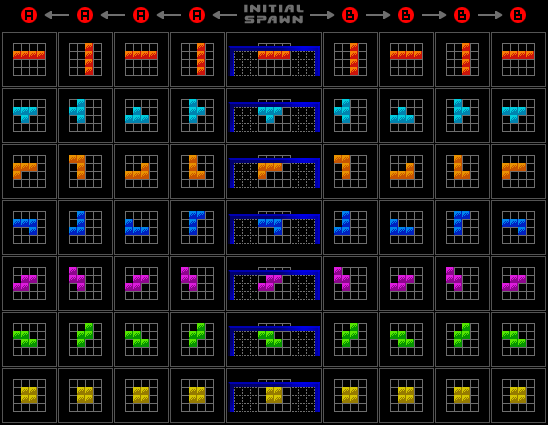Arika Rotation System
TGM rotation is a game play mechanic used in Tetris The Grand Master and other Arika tetromino games, derived from Sega rotation.
Games using TGM rotation generally use IRS, fast DAS, lock delay, and firm drop, and tetrominoes start out with the topmost block on the top row (generally row 20). Tetris The Grand Master Ace uses a hybrid of TGM rules and Guideline rules.
Basic rotation
TGM's basic rotations inherits most of its properties from Sega rotation, which was used in most previous Japanese arcade Tetris games. Some defining design choices include:
- Having 2 (as opposed to 4) rotation states for S, Z, and I pieces to simplify learning.
- Keeping pieces at an even level while rotating to always allow rotation when the piece is on a flat surface.
- Pointing the initial stance of the T, L, and J pieces downward to add some extra challenge and also make it easy to have pieces grab bumps along the surface of the stack when playing at high gravity.
Wall kicks
TGM pioneered the use of wall kicks, with simple but effective kick rules. These rules were unchanged until TGM3, remaining constant across TGM, TA, TAP, and Sakura Tetris. Up to 3 locations are tried, in this order, before rotation will fail:
- Basic rotaion
- 1 space right of basic rotation
- 1 space left of basic rotation
In addition to these rules, there are some extra exceptions where certain wall kicks are not allowed:
- The I piece will never kick.
- L, J, and T pieces will not rotate in the situations illustrated below if the
 marked block is occupied.
marked block is occupied.
|
|
| ||
|
|
| ||
|
|
- However, L pieces will rotate clockwise and J pieces counterclockwise in the situations illustrated below if both the
 marked blocks are occupied.
marked blocks are occupied.
|
|
To-Do
- describe Ti
- describe ACE's ARS and ARS2
- describe "Mihara's conspiracy"
- mention right bias
- add more visual aids?
